With our yearly fill of skiing accomplished, it was time to turn south for the long drive home. Susan and Randy had decided they needed to get home earlier than us, so we drove them to Boston, deposited them at Logan airport, then headed to the Big Apple…just as NYC was getting battered with another round of wet, slushy snow.
The plan was to get into New York early Thursday, our friends Scott and Angela would fly in later that evening from Atlanta, and we’d enjoy the weekend with them and get in a Broadway show. But, as luck would have it, that was the very day that–because of the weather–a Delta flight from Atlanta skidded off the runway at La Guardia. Fortunately, it wasn’t their flight, but unfortunately it meant they wouldn’t be arriving (via a different airline and into Newark) until the following evening.
So we found ourselves with a day–Friday–to ourselves. It was a spectacular day: the weather from the day before blew through overnight, leaving the city covered in a pristine blanket of white. If you’ve never been to New York when there’s snow on the ground and hardly a cloud in the sky, it’s hard to explain what you’ve missed. We didn’t have grand plans for the day, just a stroll through Central Park and a few hours at the Metropolitan Museum of Art.
Now, we readily and sheepishly admit that we were, apparently, Euro-museum snobs. We have suffered from the delusion that the greatest museums of the world were found in the “old world”: the Louvre in Paris, the Vatican Museum in Rome, the Prado in Madrid, and the British Museum in London. Not to mention all the “lesser” museums (man, it’s hard to call them that) like the Tate, the Rodin Museum, the Sofia Reina, the Orsay, and so on and on. After our Friday at the Metropolitan Museum of Art in New York, our eyes are opened: this is one of the greatest art museums in the world, right up there with Europe’s “big ‘uns”.
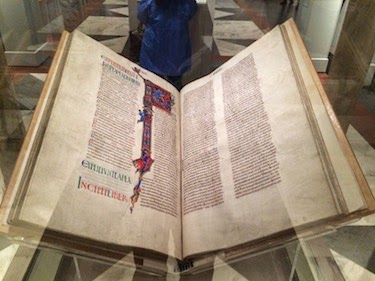 |
| The Winchester Bible |
We could easily have spent three days exploring this museum. It’s massive, with 3 floors of galleries and wings that are more than enough to get completely lost in. There’s the American Wing (with Leutze’s “Washington Crossing the Delaware” as its centerpiece); the Arts of Africa, Oceania, and the Americas gallery; Arms and Armor gallery; The Costume Institute; the Egyptian Art gallery; the European Sculpture and Decorative Arts gallery; the Greek and Roman Art gallery; the Medieval Art gallery; and the Modern and Contemporary Art gallery. And here’s the thing: these are just the galleries of the first floor and mezzanines!
It’s simply an overwhelming museum. Arrive early. Admission is technically free: rather we should say your admission fee is whatever you wish to pay, but you do have to acquire a ticket. The person at the desk might recommend a “donation” (I think it was $25 per person) and don’t hesitate to pay it: you’ll definitely get your money’s worth. There are free guided tours throughout the day: be sure to ask when the next one is, as they’re invaluable for giving you an orientation to the museum and giving you an idea of how you’d like to spend the rest of the day.
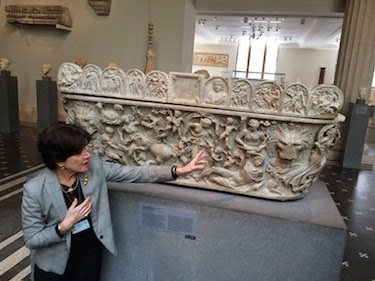 |
| Our Guide Describing An Ancient Sarcophagus |
Among the hilites of our visit were the Winchester Bible, a medieval Latin bible from England between 1050 and 1200. This bible is made of huge sheets of parchment that a single scribe, working over the course of several years, copied the entire text of the Old and New Testaments onto. At least six artists added incredibly beautiful and detailed illustrations, resulting in an impressive work of religious art that’s in remarkably good condition.
In the American Wing we found rows and rows, rooms and rooms, of portraits of Americans both famous and obscure, some of which we’ll blog about (and show you) in an upcoming blog or two. The dramatic focal point of the American Wing, though, is the painting “Washington Crossing the Delaware” by Emanuel Leutze. Seeing this iconic painting in person was a great bookend to our road trip, which (as you’ll recall) started with a visit to Washington’s Mount Vernon. Painted in 1851, long after the famous sneak attack, Leutze took some well-known factual liberties in his depiction. But given its grandeur, we’re sure you’ll forgive him, just like we did.
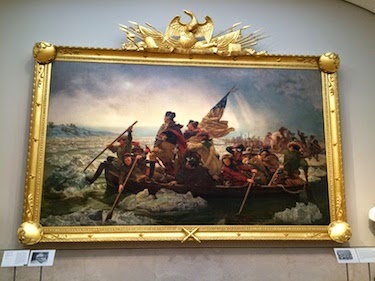 |
| Washington Crossing the Delaware |
While it’s greatly satisfying to see famous art in person, it’s also wonderful to come across those unexpected surprises that make you say, “Oh, wow!” We had two such moments at the Metropolitan Museum of Art. The first was the installation of “The Frank Lloyd Wright Room”, the living room of the summer residence of Francis W. Little from just outside of Minneapolis. Wright built the home between 1912 and 1914, and his concepts of “organic architecture” incorporated not only the structure design but also the furniture, decorations, and landscaped environs. The room practically begs you to linger, to prop your feet up with a good book.
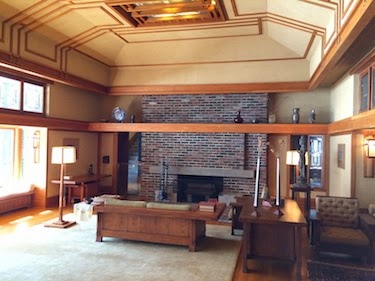 |
| The Frank Lloyd Wright Room |
The other “Oh, wow” moment came in, of all places, the Arts of Africa, Oceania, and the America’s gallery. It’s called the “Kwoma Ceiling” from the island of New Guinea. The Kwoma are an indigenous people living in the hills of Northeastern New Guinea. Kwoma villages typically have one or two ceremonial houses for meetings and rituals. The ceilings of the ceremonial houses are comprised of dozens of elaborately painted and carved panels shaped like shields; the stylized paintings are of animals, spirits, and geometric designs. The entire roof that is suspended in the Metropolitan Museum of Art was commissioned between 1970 and 1973 and executed by a group of twenty-four Kwoma artists.
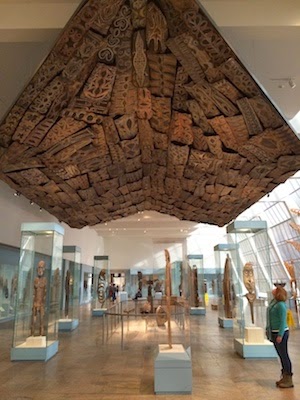 |
| Lori Admiring the Kwoma Ceiling |
We are now reformed American art museum lovers. New York’s Metropolitan Museum of Art stands among the world’s greatest museums and deserves going out of your way to visit. We’ve already put a return to New York, specifically to dedicate a couple more days to the museum, on our wish list.
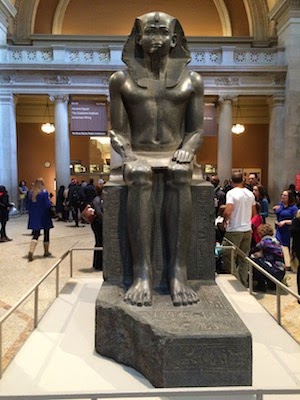 |
| From the Egyptian Art Wing |






